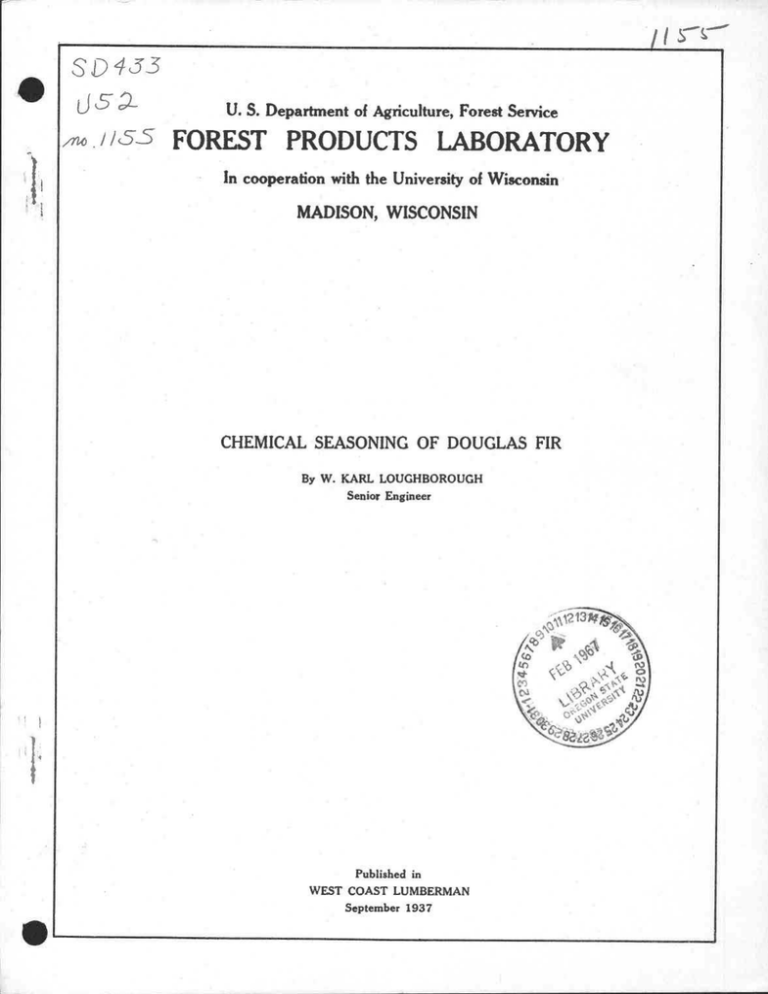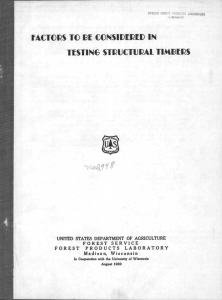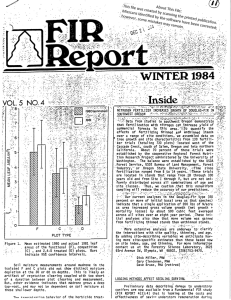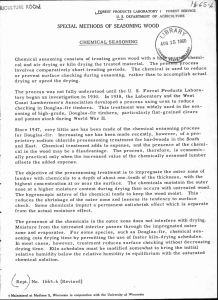I SD 433 5'0-
advertisement

SD 433
5'0-
U. S . Department of Agriculture, Forest Servic e
/S 5 FOREST PRODUCTS LABORATORY
I
In cooperation with the University of Wisconsin
MADISON, WISCONSI N
CHEMICAL SEASONING OF DOUGLAS FI R
By W. KARL LOUGHBOROUGH
Senior Enginee r
Published i n
WEST COAST LUMBERMAN
September 193 7
-
r
GMT= SEASONING
,~,S
R
By
W . KARL LOUGHBOROUGH
Senior Enginee r
1. •
I
As a result of the prelimfriary ai :tiOle on the Fmrect Produei
Laboratory method of seasoning wood with oh*m1Eals, which appeared ii.m - '
several magazinesl, considerable interest has been manifeste1d i3y th:e
subject by the lumber industry . The available information evp cl Rta-y
needs to be focused so that the industry can judge the ccNTa gVe-tRA p6s` sibilities Qf the procgss :. The broad concept of chemical sieasaji' i s
a shor t
se
.• ad .1,, = discussed
d
01anti c'1. •'t'!w
lumber in
'I .
4
1-
't emp
that?
ti,
I
~
fo knoll* then
exc e ' 3,L the f_.Q.
attar
the A
lam
/7ibRN #
istics of the dis l
and relative humi
equiWid!OW/iMat
eqa-'
t Wes1
_ R
whir-Ma
cuTq
*
kiln drying or air
'a
l- like significanc
' *hat durin g
seas
a given re hive iumiditr
-Published in the following : American Lumberman, May 1937 ; South e
Lumberman, Sept . 15, 1936 ; The Timberman, Sept . 1936 ; West Coas t
Lumberman, Oct . 1936 .
81155
N0
O
r1
to
0
N
C
4
1,
0
°c
0
r1
,C
zr.
(q
.uoo,zad) pooM UT
8 .zn4SToJA
0
0
•
fibers of salt-treated wood have a higher moisture content than th e
untreated wood just beneath the chemically treated zone . For example ,
by drying wood properly treated in a saturated solution of sodiu m
chloride in air maintained at a constant temperature of 700 F . and a t
a constant relative humidity of 75 percent, one can prevent the surfac e
of the wood from shrinking and yet ultimately dry the interior untreated portion of the timber to a moisture content of 15 percent . B y
chemical seasoning methods, therefore, it is possible to dry from th e
inside out and to prevent the surface fibers from becoming sufficientl y
dry to induce them to shrink . In this way surface checking is avoide d
because the surface fibers are not stretched as they inevitably ar e
when kiln dried or air dried without chemical treatment .
The chemical is diffused into the wood . If the moisture con tent of wood is not high enough to provide a continuous film of wate r
into which the chemical can diffuse, the action of diffusion is impeded .
The area in which diffusion can take place increases with the moistur e
content of the wood . Consequently, the amount, rate, and depth o f
penetration at which a chemical diffuses into wood are directl y
associated with its moisture content . In species like oak, for ex ample, there is enough moisture present to support diffusion at a
fairly rapid rate for a long time . On the other hand, Douglas fi r
heartwood, when green, has but little more moisture than is necessar y
to saturate its cell walls . Consequently, Douglas fir fibers do no t
have to dry very much before they lose their free water, leaving al l
the remaining moisture confined to the cell walls . While a chemica l
will diffuse in hygroscopic moisture the rate is very slow . Thu s
while Douglas fir is soaking in a chemical solution the chemica l
diffuses into the water in the wood and the water just beneath th e
treated zone diffuses outward in the opposite direction toward th e
surface and eventually is lost to the chemical solution . Owing t o
its original low moisture content, Douglas fir, when steeped in a ho t
chemical solution having a relatively low vapor pressure, soon drie s
enough to slow up the rate of diffusion materially . It has been discovered that 12 by 12-inch Douglas fir timbers have almost the sam e
salt distributions when soaked one and a half months as they have whe n
soaked for a much longer period .
Experience has shown that surface checking control can b e
accomplished by permitting the chemical to diffuse no deeper tha n
from one-half to five-eighths of an inch . This can be accomplished i n
from 4 to 10 days depending on the chemical used and the strength o f
the solution .
The rate at which Douglas fir timbers dry in a saturate d
solution of sodium chloride is about the same as that for matche d
timbers that are not in a bath but are subjected to the attained bat h
temperature and a relative humidity of 75 percent . In view of the fac t
that the drying rate increases with increasing temperature, everythin g
else being equal, it follows that when it is desired to obtain a
•
x1155
-2-
eonsiderable amount of dry4 while t -Umbers a
the bath should be Leafed .
Theoretically the rate at whiff 'a .eh i iic'a1 gdl,l• . 'iffuse int o
wood containing free water .is p;roportion:al to the absolute temperature
Igncounof the bath . Since, however, the range iti abDole .te tevapera
terad in chemioe,1 ; . seasoning is Comparatively- -s l.l, the r e . At- ich
aa@:e .
a chemical will diffuse into green Dougia: fir ma* be Qee
dryiri t
constant . Thez:efcre, with the exception of i4ncre -ko •
rate during the soaking process, elevate-a ` t+i tse i era-tur'es sere' ir .
useful purpose, and duo- to their deleterious effects on. MAO 'Olin
be avoided in treating refractory it.ems.. The maximum safe bashi-emp,owm*mP, which aa.y b e used varies with the size and the, natg1r e
of the item being treated .
_
.
The foregoing presents a rough concept of
1#a sic pri cA ik-e
involved in the Forest Products Laboratory method of cY iical seacoaln g
Do
The following paragraphs- give specific processes with respect
fir that have resulted satisfactorily .
l
1 .
.
,
-1
CrossarmsAny chemical treatment appl iled to crossairtins ,siaomIllpal ie-' or a _
type that will 'keep the electrical conductivity of the ares4 ;xi
. at a
minimum . For this reason invert sugar was used instead of .ao.A_ • : - .
chloride in the experiments on the chemical seasoning. o ergo ;WO .
When crossarms of green Douglas fir are steeped in a 40 pt .
cent solution of invert sugar for 2 days, they can be subsequently
1.4
,cmsoned without the development of cheeks to a moisture co*,fi.ott of
.
approximately 15 percent in 5 days and to 12 percent in 7 46
-, thy°
use of the following schedule :
Temperature
°F
Relative Htmidity
P erc ent
160
170
ISO
S5
62
Numib_e_r ofIoma
50
So far
cr s2OIne -CM$ li-n
'
.A 1:i g .fie tments have been end coated prior to kiln drying,, at rere :
experiments may prove this preoaation tunnecessary : Oii.no,d-a 40.
.pnt
solution of inert sugar is in ewi .1ibrii m with are-.ia: aev►e h cry
1
L
--
•
about 95 percent, crossarms treated with this chemical are apt t o
surface check and end check during subsequent air seasoning .
Wide Douglas Fir Plank s
Flat-sawed Douglas fir planks that are wide and thick requir e
careful kiln drying if surface checking is to be avoided . The expens e
of this process operates against its general adoption as a commercia l
practice . Moreover, this class of material will most surely check an d
split during normal air seasoning . Owing to these seasoning difficulties it is not surprising that wide plants are often shipped green .
Chemical seasoning methods are helpful in either kiln drying or ai r
drying such items . After steeping in a saturated solution of sodiu m
chloride maintained at 160° F . for 2 days, 3 by 12-inch flat-sawe d
planks of Douglas fir were satisfactorily kiln dried to an averag e
moisture content of 14 percent in 4 days by the following schedule :
Temperature
or .
160
170
150
Relative Humidity
Percen t
Number of Days
2
1
1
70
6o
50
One lot of flat-sawed 3 by 12-inch Douglas fir planks was
boiled in a saturated solution of sodium chloride for 4+ days during
which time they dried without degrade to an average moisture conten t
of 12 percent . At the same time the cores of these planks had an
average moisture content of 16 .5 percent .
Another lot of flat-sawed 3 by 12-inch Douglas fir planks
was steeped in a 4o percent solution of invert sugar at 120° F . fo r
2 clays and kiln dried with the salt-treated planks . (See previous
drying schedule .) When removed from the kiln these planks had a n
average moisture content of 16 percent and were free from any seasoning defect . When treated 2 days .in a saturated solution of sodiu m
chloride 3 by 12-inch planks were l;4ried in an unheated shed at Madison ,
Wis ., without checking . Matched material when treated with a 4o solution of invert sugar checked under identical drying conditions . Th e
better behavior of the salt treated planks during air seasoning is, o f
course, due to the lower vapor pressure of the salt solution .
Side-Cut Timber s
Figure 2 shows the moisture-time curve of salt-treated 6 by
12-inch timbers and also shows the drying conditions used . In tw o
previous experiments after a 2-day and 15-day treatment in a saturate d
R1 155
_L
to
CV
A
0
CV
0
C
1r'
C
CV
C'
frf
solution of sodium chloride, respectively, each group was kiln drie d
in a constant temperature of 160° F. and a relative humidity of 60 per cent without the development of seasoning degrade other than some en d
checking . As all three groups dried at about the same rate, dryin g
with an initial relative humidity of 70 percent seems the safer and ,
consequently, better practice .
Little drying should be permitted until a reasonable amoun t
of chemical has diffused into the timbers if end checking in the bat h
is to be entirely prevented . The 3-day chemical treatment was planne d
with this in mind . It consisted of adding sufficient salt to col d
water containing the timbers to bring the solution to about 30 percent
of saturation (inequilibrium with about 93 percent relative humidity )
after which it was allowed to stand 24 hours during which time the bat h
was well agitated . Next the solution was increased to about 70 percen t
of saturation (in equilibrium with about g4 percent relative humidity )
and the bath was left for another 24 houxs . The solution was the n
saturated (equilibrium at 75 percent relative humidity) and the tempera ture gradually elevated to 160° F. where it was maintained from 6 to g
hours . If it is necessary to dry timbers of this size perfectly fre e
from end checks, some such treatment as the foregoing must be given .
The amount of end checking that occurs when 6 by 12-inch side-cut
Douglas fir timbers are treated at room temperatures in a saturate d
solution of sodium chloride perhaps is not large enough to warran t
the additional expense of gradually increasing the solution strengt h
of low vapor pressure solutions . Experiments have shown that whe n
certain end coatings are applied to timbers prior to treatment th e
hazard of end checking is greatly reduced . Therefore, under certai n
circumstances perhaps end coatings can be profitably used in chemicall y
seasoning timbers of this kind .
To date, air seasoning experiments following chemical treat ment have not included large side-cut timbers . However, the kiln con ditions used in drying the foregoing three groups of timbers were mor e
severe than would be normally found in any part of the United State s
except the arid Southwest . It is reasonable to infer, therefore, tha t
side-cut Douglas fir timbers up to 6 by 12 inches in size can b e
successfully air seasoned after treating in a chemical solution whic h
has approximately the same vapor pressure as a saturated solution o f
sodium chloride . It is suggested, however, that for best results th e
air seasoning should be accomplished in an open shed .
12 by 12-inch Boxed-Heart Douglas Fir Timber s
By chemical seasoning methods the prospects of successfull y
seasoning boxed-heart timbers are more promising than heretofore .
Large boxed-heart timbers of Douglas fir can be chemically treate d
and then satisfactorily kiln dried without checks provided the kil n
M.1 55
-5-
is susceptible of close relative humidity and temperature control .
The major portion of the drying can be accomplished either in th e
kiln or in a chemical solution, depending upon which procedure is th e
more expedient . Soaking the timbers for a period of 2 weeks is long
enough to give the desired penetration of the chemical . If seasonin g
is to be accomplished in the solution, the bath temperatures shoul d
not exceed 160° F . at any time . In order to prevent end checking i n
the bath it is necessary to maintain the temperatures as low as pos sible for the first week . In using sodium chloride it is best t o
bring the concentration of the solution up to saturation gradna .lly .
This procedure reduces the rate of end drying while the timbers ar e
in she bath and permits a more adequate treatment of the and grain .
Figure 3 shows the drying schedule used in kiln drying 12 by 12-inc h
boxed-heart Douglas fir timbers after a l4-day treatment in the sal t
bath . From the curve it may be seen that this class of material can
be dried to a moisture content of 16 percent in approximately g 5 days .
;;
r
l
a
pliN
•
a
- , _$
r
Commercial_ Aspects+ ; 11 ; r+
k
1, ! f
_
lb_
The experiments conducted so far at the Forest Products La b
ratory on chemical seasoning have been directed toward only one problem ;
namely, the drying of large timbers and refractory items of wood with out seasoning degrade . The experiments have been so satisfactory a s
to make it desirable to give serious consideration to the commercia l
application of the results . For example, thought should be given (a )
to the best type of equipment and the ultimate cost of the treatment ,
(b) to means of preventing the surface of timbers from becoming dam p
when exposed to high relative humidities, (c) to means of controllin g
the loss of electric current in items which demand high electrica l
insulation, (d) to the matter of controlling the corrosion of meta l
fastenings used in the assembly of salt treated wood .
The experiments indicate that the cost of the absorbed Che m
teal is low . In general, a satisfactory chemical treatment is on e
which the weight of the absorbed chemical is equal to 2 percent o f
weight of the oven-dry wood . In timbers as large as 12 by 12 inche s
in size this amount of chemical is somewhat excessive, but for purpose s
of cost estimation the 2 percent value may be considered as a constan t
for all sizes . If the cost of chemical treatment and subsequent kil n
drying is assumed to be 300 a thousand board feet per day, it is eas y
to estimate the cost of drying various sized timbers by this process .
The following table shows the estimated costs of chemically seasonin g
the indicated items of Douglas fir from a green condition to a moistur e
content of 15 percent . The values are fet down as calculated, and ar
to be considered merely as guides .
. :te r
----
-----
_- f ---
~,~--~-
I
i
1
_
-E
!,
o
[x;
r- o
HE
__
I
o %P.
f:e
Lr,
I
.~
~
~ T_
Table l .--Estimated cost of chemically seasoning four items 1
. ..Douglasfir
.
Drying period
including time
in the chemical
solution
'r
Crossarms ---- :
Days
Cost per thousan d
feet, BM
:
: Drying : Chemical at
10 p er
poun d
.
.
1 .6o*
:
:
Total
cos t
.
7
: $ 2 .10 :
3 by 12
6
1 .80 .
.4 5
2 .2 5
6 by 12
26
•
7 .80
.4 5
8 .2 5
96
▪
.45
29 .2 5
12 by 12 . . . .
.
28 .80
$ 3 .7 0
411br this item o n-'Cy ; inv̀er~ -sugar 41901 'IPOL'iPt
of electric current in crossaftil M
:
sugar is fis tgilsagtrafir. .ite,. 4 aaspialltOL,
wdivait-gsizs ,
large, dry
water are net enO-Da id 'pay for
ased
i
the fact that..
board.
a1- 570 pmger&'s
feet are removed n1s.ml-101t.glO.s fir by drying f-rO(I a greeg Rota-0teQ.on to'
)
a moisture .coot'nt of 15 Forp'snt, which at a MO freight--ei l V.mounts I
to a saving of $)4- .10 gaga d.f.iAdir timbers are v1140906 ite;rkS,,ev 'of green .
According to thee4: e cX-lea'at-46hs, if the cost of sft.soningals,bail q).q
borne by the r-eduee-d i-re,gits-fhar,ges, sizes'. mkt* .1 arcer t*ltr -5 Ar
inches must ountinue
hand, *hen
'
ShIpped green:., IOW
,qAt%t
green refruct.ciry material of targe size iS
40lr the use Antended, wal•k,iri,g beams. .for example, c4letroie-a). Oas =in& offers a po
le
Solution.
I
I
1
2-
ir l
-l
11-
trelixtitta:ty e-.-Iwft'iments ipdi-cafe. rgr.a,bt
VOrSPiel.w
rt
ing of material 'of smaller size, moil, as . 4/4 mcl. * 3'. . . ate.
of
common grade, -o ' .eras good promise . The us.-Inal .dgy-O.:g period IteAuired
IT
to season these items can be -elduoedl by ch .eilid'al tI ;-sridlIng methbld.s..
at '
Moreover, it
ossibl•e. that t-he reduction i3A .0kierd1:10 to 10, s et
r- 7
knots will be s .omewhat leis than w1h.wi straight -mot , dwarf
This will be 'eest realized wleeln oiserlicals t:tmft.iz
isOfir-iifet
Ll :Er
properties are used ..
H
ri j
11W 1_
• ;.
-1
1
1
Summary
Several items of Douglas fir have been satisfactoril y
chemical seasoned on a laboratory scale green from the saw to a
moisture content of 7 percent, which is a degree of seasoning no t
normally attained in use . Crossarms, 3 by 12 flat-sawed planks ,
6 by 12 side-cut timbers, and 12 by 12 boxed-heart timbers wer e
dried to a moisture content of 15 percent practically free of sea soning blemishes in 7, 6, 26, and 96 days, respectively . The cos t
of chemical seasoning the smaller items would probably be less tha n
them to the same standard o f
the cost of air dr
or. .lc.ln dr'
tally
probabl y
.
,lemt
fig
be grear " .
ically seasoned timbers is vastly superior .
CD
41
cd
•
a
o
•
m
o
co
o0
on
El
o 1t
1-f
.
o
-P
o]F-1
O
0 k
a) a)
0
g
ak
aH 4i
ra •ri
I a
LJ
„0
a)
N .04-1 4.4 o
ri
cd o
Ia• a) w -P +)
w ITIo
O
CV k ••• +' rd
r-1 ri +) 0
cd
o a)
4{
a) 0 , .q
+1
q k0
CD
a)
4-1
wP a
A
•
L[1 O cd •
-N ...,-1 •rl O ri
• ail
a)
o
o ai alri
I •
1 ta -p
k q
N• ON a
4-1
a) E A
▪ -P
rd-)
a)
O k , .b
+)~ 0
40 k a)
ow-I 1:g 4"
Po
q 0
4D k
+P
00 •rl a) m
rl k" i-' a)
u 4-1
ccl 4-)
m
rI cd
o
a) w 0
• m
,0
s
IAI .o
`°
4ti
O
•
a) m
U •r I
a )k k O
o
a 'cd
rl Lcw ri1
q
• 4 l y-1
1
+1
O
(0
r-i
1
q
a) a) o
o -P m
a) E A ni
-P •r4 0 a)
ai + 1 0
P4
wi
M
A.
N





